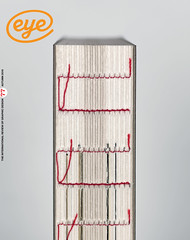Autumn 2010
Adventures in motion pictures. Neil McIntosh
‘You can’t scan-read a five-minute film.’ Interview with Neil McIntosh, editor of Wall Street Journal Online Europe
Eye magazine: When is an audio slideshow appropriate, and when is video better?
Neil McIntosh: Audio slideshows have advantages in the way they’re produced – thus far, it has been easier to get good photographs and audio out of a situation than with video. Maybe that will change now we have video capabilities in DSLRs, but there are advantages, too, in the way users consume them: slideshows still work in office environments, where users can’t or don’t want to listen to audio.
Audio slideshows can be very powerful bits of journalism. They can combine the best of still photography with the best of radio. It can be a rich experience, but still one that leaves something to the imagination.
Video works best where the footage bears witness to something that’s best seen, not described. The tools we have now mean that video can be turned around and put online quickly. Audio slideshows are better for features than news.
EM: Do you think online journalism will move entirely to video-based photojournalism?
NM: Video is booming. On the supply side, more and more video is becoming available, from syndication, from photographers with video kit – even users with an HD camera phone. Publishers are keen to incorporate video into their coverage.
On the demand side, there’s an advertising model around video which means that some publishers may want to invest in video over other content types.
Users are lapping up high-quality video, but we may find there’s a finite appetite in the longer term. Video’s harder to consume than text, still images or graphics. It’s a time commitment that many are unwilling to make. You can’t scan-read a five-minute film. So I think as an industry we’d be unwise to pile into video and ignore the development of other forms of storytelling.
EM: How do photographers view this change?
NM: I’ve been fortunate to work with pioneers like the Guardian’s Dan Chung, who push to experiment with new technology and techniques. Online represents a big opportunity, both in stills and video.
First published in Eye no. 77 vol. 20.
Eye is the world’s most beautiful and collectable graphic design journal, published quarterly for professional designers, students and anyone interested in critical, informed writing about graphic design and visual culture. It is available from all good design bookshops and online at the Eye shop, where you can buy subscriptions, back issues and single copies of the latest issue. You can also browse visual samples of recent issues at Eye before You Buy.

